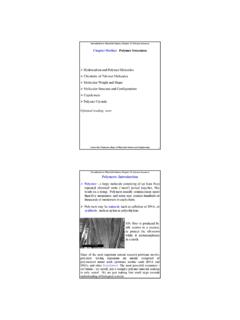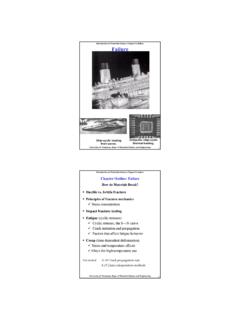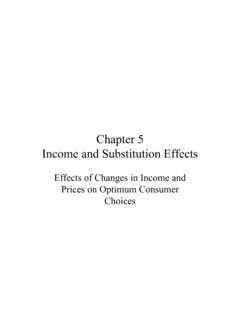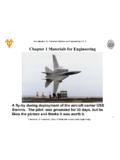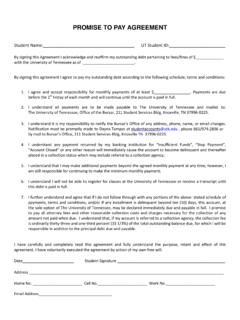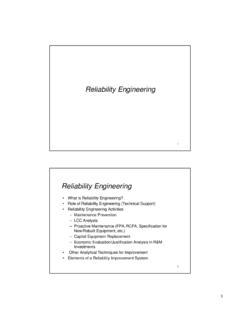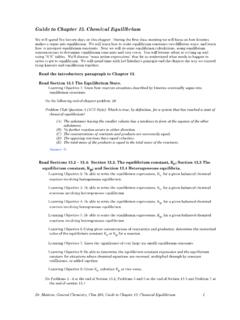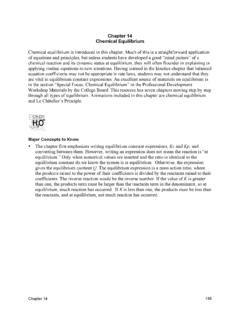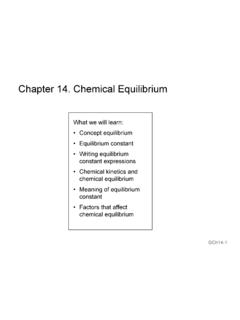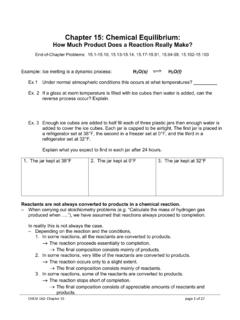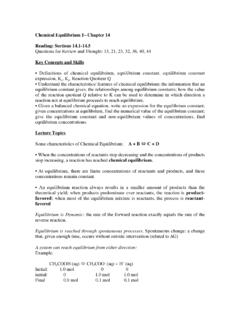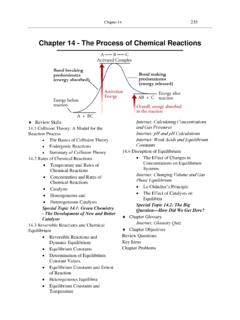Transcription of Chemical Equilibrium - University of Tennessee
1 1 chapter 14 ChemicalEquilibriumHill, Petrucci, McCreary & Perry 4thEd. Many Reactions seem to STOP before all the reactants are used up. The Concentrations of Reactantsand Productsreach constant values. A State of Chemical Equilibriumis said to have been established, but nothing stopped! Chemical Equilibrium is a Dynamic StateRateForward Reaction= RateReverse ReactionChemical EquilibriumThe Hydrogen Iodide Decomposition2 HI(g)H2(g) + I2(g)[HI]2Kc =[H2][I2]Only this form of the Equilibrium expression gives a constant ratio.
2 The exponents here are the same as thecoefficients in the Chemical equilibriumconstant is actuallythe ratio of the rateconstants for the forward and reversereactions! Kc = x 10-2 at 698 K This value of the Equilibrium constant is valid only at 698 K! 2 The Kinetic View of Equilibrium2 HI(g)H2(g) + I2(g)Rate of the forward reaction: Rate = kf [HI]2 Rate of the reverse reaction: Rate = kr [H2][I2] At Equilibrium the rates are equal: kf [HI]2 = kr [H2][I2][HI]2Kc =[H2][I2]=kfkrThe Value of an Equilibrium Constant2 HI(g)H2(g) + I2(g)[HI]2Kc =[H2][I2] = x 10-2 at 698 K A value for any one concentration may be calculated if the others are known.
3 [HI]2=[H2][I2] x 10-2[HI] =[H2][I2] x 10-212 General Equation for EquilibriaFor the General Equation:a A + b B + ..g G + h H + .. The Equilibrium Expression will have the form: Kc =[G]g[H]h ..[A]a[B]b ..The Equilibrium Expression will always have the form: Kc =[products]n[reactants]m3 Calculating an Equilibrium ConstantNeed: Balanced Chemical Equation Initial Concentrations of all species One Equilibrium ConcentrationAlternatively the initial moles of all species and one Equilibrium mole plus the volume of the container ConcentrationsDecomposition of Hydrogen Iodide at 731 moles of HI(g) in a L container was decomposed at 731 K.
4 The amount of I2(g) at Equilibrium was foundexperimentally to be mole. Calculate value of Chemical equation:2 HI(g)H2(g) + I2(g) from the stoichiometry:-2x+x+x Initial concentrations from data:[HI]o = L= M[H2]o = [I2]o = 0 [I2]eq = L= M Can You Solve This Problem?balanced Chemical equation:2 HI(g)H2(g) + I2(g) [initial] M0 M0 M[ Equilibrium ] M from the stoichiometry:-2x+x+x 4 Variations of Equilibrium Expressionsbalanced Chemical equation:2 HI(g)H2(g) + I2(g) = Kc =[H2][I2][HI]2If the equation is reversed.
5 2 HI(g) H2(g) + I2(g)K'c =[H2][I2][HI]2== 'c is the reciprocal of Kc Equilibrium Expressions other than Kcbalanced Chemical equation:2 HI(g)H2(g) + I2(g) = =[H2][I2][HI]2 Quantities proportional to moles/liter can be substituted for Molarity: From PV = nRT the ideal gas equation M = nV= PRT Kc =[H2][I2][HI]2= PRTI2H2HI PRT PRT2 = PI2H2HI P P2= Kp Kp = Kc only when # moles reactants = # moles products. Kp = Kc(RT) n Decomposition of PCl5 PCl5(g)PCl3(g)Cl2(g)+Kc = x 10-2 at 191o; Calculate Kp n = # moles product - # moles reactant Kp = Kc (RT) n n = 2 - 1 = 1TK = 191 + 273 = 464 K Kp = Kc (RT) n Kp = ( x 10-2 M) [ ( L atm )( 464 K)]1 K molKp = atm 5 Value of Kc & The Extent of ReactionKc =[products]n[reactants]mValue of Kc for Reactions Added TogetherKctotal= Kc1x Kc2x.
6 Kc >> 1 Reaction goes to completion!Kc << 1 Very little Product Forms!Homogeneous versusHeterogeneous Equilibria Homogeneous Equilibria All species have the same phase, all gas, liquid etc. Heterogeneous Equilibria Some species have different phases - Only the Principal Phase, usually the most mobile is in the Kc Fe(s) + 4 H2O(g)Fe3O4(s) + 4 H2(g) Kc = [H2]4[H2O]4 Can You Write Equilibrium Expressions for the Following Reactions?CaCO3(s)CaO(s) + CO2(g)H2O(l)H2O(g)C(s) + H2O(g)CO(g) + H2(g)6 The Reaction Quotient, QPredicting the Direction of Net Change2 HI(g)H2(g) + I2(g) For any real system at Equilibrium : = x 10-2 at 698 K [HI]2Kc =[H2][I2]For any real system NOT at Equilibrium .
7 [HI]2Qc =[H2][I2]= Any value If Qc > Kc the reaction will go toward more reactants If Qc < Kc the reaction will go toward more products When a change (concentration, temperature, pressure or volume) is imposed on a system at Equilibrium , the system responds by attaining a new Equilibrium condition that minimizesthe impact of the imposed change. Adding reactants will cause more product to form, and conversely. Removing Products will cause more product to form, and conversely. Increasing temperature will cause a shift in the endothermicdirection, and Chatelier s PrincipleLe Chatelier s PrincipleN2(g) + 3 H2(g)2 NH3(g) At Equilibrium :[N2][H2]3Kc =[NH3]2 Change: Add hydrogen!
8 [NH3]2[N2]= Qc [H2]3< Kc New Equilibrium :[N2]= Kc[NH3]2[H2]3 The reaction will react to reduce the excess H2 by combining it with N2to produce more NH3. From the newconcentrations N2 & H2 will decrease and NH3 will increase until Qc = Chatelier s PrincipleN2(g) + 3 H2(g)2 NH3(g) At Equilibrium :[N2][H2]3Kc =[NH3]2 Change: Remove Nitrogen! [NH3]2[N2]= Qc > Kc [H2]3 The reaction will react to produce more N2 by decomposing NH3 ,the concentrations of N2 & H2 will increase until Qc = Kc.
9 New Equilibrium : [N2]= Kc [H2]3[NH3]2Le Chatelier s PrincipleN2(g) + 3 H2(g)2 NH3(g) At Equilibrium : [N2][H2]3Kc =[NH3]2 Change: Remove ammonia! [NH3]2[N2][H2]3= Qc < Kc The reaction will react to to produce more NH3 by combining H2 with N2 & H2 concentrations will decrease and NH3 will increase until Qc = Equilibrium : [N2][H2]3= Kc [NH3]2Le Chatelier s Principle H < 0 (exothermic) N2(g) + 3 H2(g)2 NH3(g)At Equilibrium : [N2][H2]3 Kc =[NH3]2 Change: Increase Temperature! The forward reaction will speed up less than the endothermic reverse reaction.
10 This change actually changes Kc. The newK'c will be smaller than the old.[NH3]2[N2][H2]3= Qc > K'c Kc = kfkrK'c = kfkrNew Equilibrium : [N2][H2]3= K'c[NH3]2< Kc 8 Changing the Pressure by Compression of VolumeN2O4(g)2 NO2(g) n = 1 Kc =[NO2]2[N2O4]=[x]2[y]<[2x]2 [2y]Increasing pressure bycompression causes thenumerator to becomelarger than position of Equilibrium will shift to the side having fewer molecules. 2 HI(g)H2(g) + I2(g) n = 0 Kc =[HI]2[H2][I2]=[y]2[x][x][2x][2x] [2y]2=Increasing pressure by compressing the volume has no effect on the ratio, numerator and denominator increase to the same extent.
